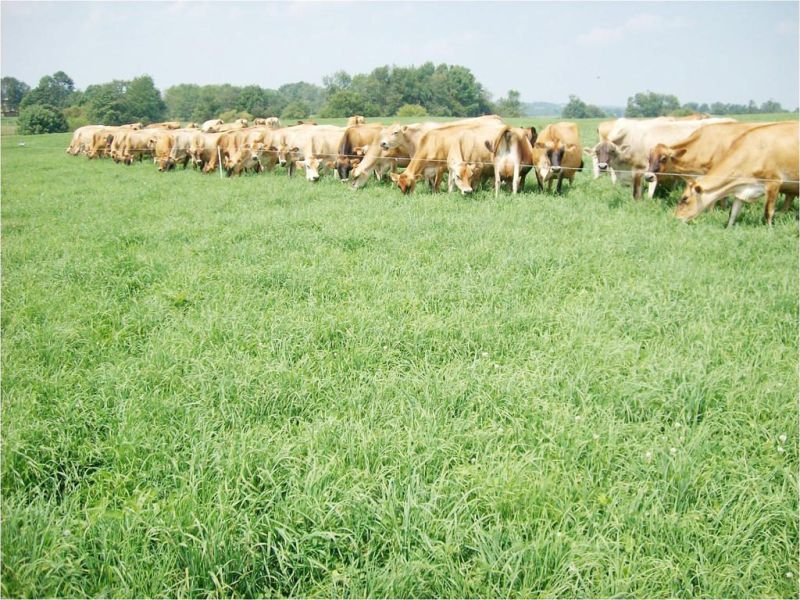Don't let livestock out at the first sign of green
- Michelle Wood: SWCD
- May 5, 2018
- 2069
It’s finally starting to feel a little bit like spring out there. Cooler temperatures, late snow and a slow turn to spring has resulted in pastures that are just now starting to show signs of waking up from winter dormancy.
I have seen pastures that haven’t been touched yet and other pastures that have had livestock on them all winter. For those of you who have livestock and haven’t been out on pasture yet, it is probably agonizing just waiting for the grass to perk up and start growing enough to graze, all the while staring at the dwindling hay supply.
I recently read an informative article by Troy Bishopp (The Grass Whisperer). It is full of great reminders about spring-grazing management. He focuses on how critical spring is for grazing-management decisions and how what you do over the next couple of months can greatly influence the entire grazing season. My favorite excerpt from that article is below:
“First grazing of spring is always difficult. You’ve got animals transitioning their rumens to high-protein rocket fuel, the weather is very unpredictable with a good chance of mud, and you have to somehow predict grass production within a sward that has clumps of orchardgrass and a low carpet of everything else. How do you get the animals to just take one bite and move on anyway?”
At this time of year it’s invaluable to take stock of what feed you have on the farm, how many animals, how much they’re eating daily, how available local feed is and at what price, and how the pastures are coming on and which ones may be ready first.
My grazier friend Rob Moore says, “A bale fed in early spring and waiting till the grass is ready will be worth four bales of summer grass production,” not to mention the fertility. And crazy weather this time of year means we need to have the risk-management plan of feed on hand anyway.
Unless you’re reducing grass competition in an effort to over-seed a pasture or some other goal, overgrazing in the spring should be avoided.
“Early spring grazing damages plants and limits herbage production by removing leaf area from grass that has not recovered from winter dormancy,” said Lee Manske, range scientist at North Dakota State University’s Dickinson Research Extension Center. “That reduces the forage available to livestock later in the season and decreases profits.”
Pastures should not be grazed until the three- to four-leaf stage or when the plants are at least 6-8 inches tall. If you have a high proportion of legumes in the pasture, do not graze until the plants are 8-12 inches tall.
Significant research has showed grazing plants before the third-leaf stage can result in the loss of over 60 percent of the potential forage yield. Grazing one week too early in the spring will sacrifice three weeks of grazing in the fall.
According to Manske, “When 25 percent of the grass tillers leaf area is removed during the first grazing period, the quantity of secondary tillers increases 38 percent during that same growing season and increases 64-173 percent during the second growing season. When 50 percent of the grass tiller leaf area is removed during the first grazing period, the quantity of secondary tillers decreases 53 percent that same growing season and decreases 63-144 percent during the second growing season.”
One of the lines in his article stood out for me: “Grazing one week too early in the spring will sacrifice three weeks of grazing in the fall.” That is a huge impact.
The key factor to take away from this is to watch your forage growth and base your turnout on mainly that. This year is a prime example of that.
The calendar says May, but the lack of pasture grass growth may be saying April or even earlier. Watch the forage growth and resist the temptation to let the livestock out at the first sign of green.
It’s been a tough winter for forages. Let them have a chance at recovering from winter dormancy before they must deal with the stress of grazing as well.
Contact the Holmes Soil & Water Conservation District and Natural Resources Conservation Service for more information about grazing, call 330-674-2811 ext. 3, visit the website at www.HolmesSWCD.com or stop by at 62 W. Clinton St., Millersburg.
NRCS resource conservationist Gina Schworm covers Holmes and Coshocton counties and specializes in grazing.




